အိုပေါ့ဆမ်ကောင်
| အိုပေါ့ဆမ် တက်ဆွန်အမည်။ Didelphidae | |
|---|---|
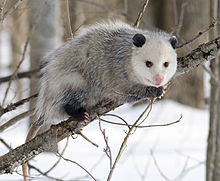
| |
| ဗာဂျီးနီးယား အိုပေါ့ဆမ် (Didelphis virginiana) | |
| မျိုးရိုးခွဲခြားခြင်း | |
| လောက: | Animalia |
| မျိုးပေါင်းစု: | Chordata |
| မျိုးပေါင်း: | Mammalia |
| Infraclass: | Marsupialia |
| မျိုးစဉ်: | Didelphimorphia Gill, 1872 |
| မျိုးရင်း: | Didelphidae Gray, 1821 |
| မျိုးစုများ | |
|
အမျိုးကွဲများ; စာပိုဒ် ကြည့်ရန် | |
အိုပေါ့ဆမ်ကောင်သည် အမေရိကတိုက်တွင်တွေ့ရသော သားပိုက်ကောင် တစ်မျိုးဖြစ်သည်။ ထူးဆန်းသည့် သားပိုက်ကောင်အမျိုးမျိုးကို ဩစတြေးလျတိုက်နှင့် အနီးတစ်ဝိုက်ရှိ ကျွန်းများတွင်သာ တွေ့ရသော်လည်း အိုပေါ့ဆမ်သားပိုက်ကောင်တစ်မျိုးကိုကား အမေရိကတိုက်၌သာ တွေ့ရသည်။
အိုပေါ့ဆမ်ကောင်သည် မာဆူပီယာလီးယား မျိုးစဉ်မှ ဒိုင်ဒယ်ဖီဒီးမျိုးရင်းတွင် ပါဝင်သည်။ ကင်ဂရူးကောင် ကဲ့သို့ ဝမ်းပိုက်ပြင်ဘက်တွင် သားအိတ်ရှိသော်လည်း ခြေလက်လေးချောင်းစလုံးသည် အရှည်ချင်းညီကြသဖြင့် ကင်ဂရူးကောင်လောက် မခုန်နိုင်ချေ။ မြေပေါ်၌ ကောင်းစွာလမ်းမလျှောက်နိုင်သော်လည်း သစ်ပင်တက်ရာ၌ အလွန်ကျွမ်းကျင်သည်။
အိုပေါ့ဆမ်ကောင်များကို တောင်အမေရိကတိုက်နှင့် ဗဟိုအမေရိကတို့အပြင် အမေရိကန်ပြည်ထောင်စု မြောက်ဘက်အစွန်ဆုံး အပိုင်းများမှတစ်ပါး အခြားနယ်အနှံ့အပြားတွင် တွေ့ရသည်။ အချို့ အိုပေါ့ဆမ်ကောင်များသည် ကြွက်ဝမ်းဖြူ လောက်ငယ်၍ လူသိအများဆုံး ဗာဂျင်းနီးယားအိုပေါ့ဆမ်ကောင် များမှာကား ကြောင်လောက်ပင်ကြီးသည်။ ယင်းတို့၏ အမွေးအတွင်းပိုင်းသည် ချော၍တို၏။ အပြင်ပိုင်းမှာ ကြမ်းတမ်း၍ ရှည်ပြီးလျှင် ပြာလဲ့လဲ့အရောင်ရှိသောကြောင့် သစ်ပင်ပေါ်၌ရှိနေ သည့်အခါ အလွယ်တကူ မမြင်နိုင်ချေ။ ဦးခေါင်းမှာသေးပြီး လျှင် နှုတ်သီးချွန်၏။ ကြွက်မြီးနှင့်တူသည့် ရှည်သောအမြီးရှိရာ အချို့မျောက်များကဲ့သို့ ယင်းအမြီးကို သစ်ပင်သစ်ကိုင်း တက်ရာ တွယ်ရာ၌ အသုံးပြုသည်။[၂]
အမျိုးအစားများ
[ပြင်ဆင်ရန်]Voss and Jansa (2009)[၃] အမျိုးအစားခွဲခြားခြင်း ဆောင်ရွက်မှုအပေါ်တွင် အခြေခံထားသည်။
| ||||||||||||||||||||||||||||||||||||||||||||||||||||||||||||||||||||||||||||||||||||||||||||||||||||||||||
- Genus Sairadelphys
- Sairadelphys tocantinensis
- Subfamily Glironiinae
- Genus Glironia
- Bushy-tailed opossum (Glironia venusta)
- Genus Glironia
- Subfamily Caluromyinae
- Genus Caluromys
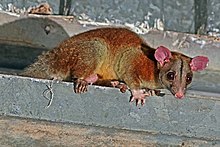
Derby's woolly opossum, Caluromys derbianus - Subgenus Caluromys
- Bare-tailed woolly opossum (Caluromys philander)
- Subgenus Mallodelphys
- Derby's woolly opossum (Caluromys derbianus)
- Brown-eared woolly opossum (Caluromys lanatus)
- Subgenus Caluromys
- Genus Caluromysiops
- Black-shouldered opossum (Caluromysiops irrupta)
- Genus Caluromys
- Subfamily Hyladelphinae
- Genus Hyladelphys
- Kalinowski's mouse opossum (Hyladelphys kalinowskii)
- Genus Hyladelphys
- Subfamily Didelphinae
- Tribe Metachirini

Brown four-eyed opossum, Metachirus nudicaudatus - Genus Metachirus
- Brown four-eyed opossum (Metachirus nudicaudatus)
- Genus Metachirus
- Tribe Didelphini

Water opossum, Chironectes minimus - Genus Chironectes
- Water opossum or yapok (Chironectes minimus)
- Unnamed subgroup
- Genus Lutreolina
- †Lutreolina biforata[၅]
- Lutrine or thick-tailed opossum (Lutreolina crassicaudata)

Lutrine opossum, Lutreolina crassicaudata - †Lutreolina materdei[၆]
- Lutreolina massoia[၇]
- †Genus Hyperdidelphys
- Unnamed subgroup
- Genus Didelphis
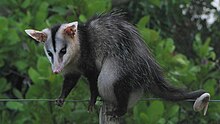
White-eared opossum, Didelphis albiventris Big-eared opossum, Didelphis aurita 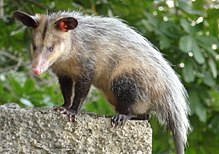
Common opossum, Didelphis marsupialis 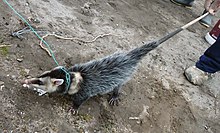
Andean white-eared opossum, Didelphis pernigra - White-eared opossum (Didelphis albiventris)
- Big-eared opossum (Didelphis aurita)
- Guianan white-eared opossum (Didelphis imperfecta)
- Common opossum (Didelphis marsupialis)
- Andean white-eared opossum (Didelphis pernigra)
- †Didelphis solimoensis[၈]
- Virginia opossum (Didelphis virginiana)
- Genus Philander
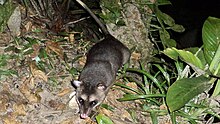
Gray four-eyed opossum, Philander opossum - Anderson's four-eyed opossum (Philander andersoni)
- Deltaic four-eyed opossum (Philander deltae)
- Southeastern four-eyed opossum (Philander frenatus)
- McIlhenny's four-eyed opossum (Philander mcilhennyi)
- Mondolfi's four-eyed opossum (Philander mondolfii)
- Olrog's four-eyed opossum (Philander olrogi)
- Gray four-eyed opossum (Philander opossum)
- †Genus Thylophorops
- Genus Lutreolina
- Genus Chironectes
- Tribe Marmosini
- Genus †Hesperocynus
- Genus Marmosa
- Subgenus Marmosa

Robinson's mouse opossum, Marmosa robinsoni - Heavy-browed mouse opossum (Marmosa andersoni)
- Isthmian mouse opossum (Marmosa isthmica)
- Rufous mouse opossum (Marmosa lepida)
- Mexican mouse opossum (Marmosa mexicana)
- Linnaeus's mouse opossum (Marmosa murina)
- Quechuan mouse opossum (Marmosa quichua)
- Robinson's mouse opossum (Marmosa robinsoni)
- Red mouse opossum (Marmosa rubra)
- Simon's mouse opossum (Marmosa simonsi)
- Tyler's mouse opossum (Marmosa tyleriana)
- Marmosa waterhousei
- Guajira mouse opossum (Marmosa xerophila)
- Zeledon's mouse opossum (Marmosa zeledoni)
- Subgenus Micoureus

Tate's woolly mouse opossum, Marmosa paraguayanus - Alston's mouse opossum (Marmosa alstoni)
- White-bellied woolly mouse opossum (Marmosa constantiae)
- Woolly mouse opossum (Marmosa demerarae)
- †Marmosa laventica[၁၀]
- Tate's woolly mouse opossum (Marmosa paraguayanus)
- Little woolly mouse opossum (Marmosa phaeus)
- Bare-tailed woolly mouse opossum (Marmosa regina)
- Subgenus Marmosa
- Genus Monodelphis
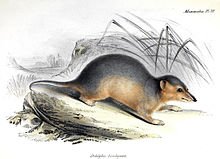
Yellow-sided opossum, Monodelphis dimidiata 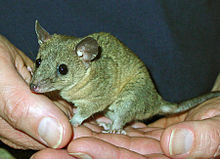
Gray short-tailed opossum, Monodelphis domestica - Sepia short-tailed opossum (Monodelphis adusta)
- Northern three-striped opossum (Monodelphis americana)
- Monodelphis arlindoi[၁၁]
- Northern red-sided opossum (Monodelphis brevicaudata)
- Yellow-sided opossum (Monodelphis dimidiata)
- Gray short-tailed opossum (Monodelphis domestica)
- Emilia's short-tailed opossum (Monodelphis emiliae)
- Amazonian red-sided opossum (Monodelphis glirina)
- Handley's short-tailed opossum (Monodelphis handleyi)[၁၂]
- Ihering's three-striped opossum (Monodelphis iheringi)
- Pygmy short-tailed opossum (Monodelphis kunsi)
- Marajó short-tailed opossum (Monodelphis maraxina)
- Osgood's short-tailed opossum (Monodelphis osgoodi)
- Hooded red-sided opossum (Monodelphis palliolata)
- Monodelphis pinocchio
- Reig's opossum (Monodelphis reigi)
- Ronald's opossum (Monodelphis ronaldi)
- Chestnut-striped opossum (Monodelphis rubida)
- Monodelphis saci
- Monodelphis sanctaerosae[၁၃]
- Long-nosed short-tailed opossum (Monodelphis scalops)
- Southern red-sided opossum (Monodelphis sorex)
- Southern three-striped opossum (Monodelphis theresa)
- Monodelphis touan[၁၁]
- Red three-striped opossum (Monodelphis umbristriata)
- One-striped opossum (Monodelphis unistriata)
- Genus †Sparassocynus[၁၄]
- Genus †Thylatheridium
- Genus Tlacuatzin[၃]
- Grayish mouse opossum (Tlacuatzin canescens)
- †Genus Zygolestes
- †Zygolestes tatei
- Tribe Thylamyini
- Genus Chacodelphys
- Chacoan pygmy opossum (Chacodelphys formosa)
- Genus Cryptonanus
- Agricola's gracile opossum (Cryptonanus agricolai)
- Chacoan gracile opossum (Cryptonanus chacoensis)
- Guahiba gracile opossum (Cryptonanus guahybae)
- †Red-bellied gracile opossum (Cryptonanus ignitus)
- Unduavi gracile opossum (Cryptonanus unduaviensis)
- Genus Gracilinanus
- Aceramarca gracile opossum (Gracilinanus aceramarcae)
- Agile gracile opossum (Gracilinanus agilis)
- Wood sprite gracile opossum (Gracilinanus dryas)
- Emilia's gracile opossum (Gracilinanus emilae)
- Northern gracile opossum (Gracilinanus marica)
- Brazilian gracile opossum (Gracilinanus microtarsus)
- Genus Lestodelphys
- Patagonian opossum (Lestodelphys halli)
- Genus Marmosops
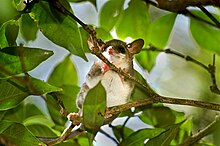
Gray slender opossum, Marmosops incanus - Bishop's slender opossum (Marmosops bishopi)
- Narrow-headed slender opossum (Marmosops cracens)
- Creighton's slender opossum Marmosops creightoni
- Dorothy's slender opossum (Marmosops dorothea)
- Dusky slender opossum (Marmosops fuscatus)
- Handley's slender opossum (Marmosops handleyi)
- Tschudi's slender opossum (Marmosops impavidus)
- Gray slender opossum (Marmosops incanus)
- Panama slender opossum (Marmosops invictus)
- Junin slender opossum (Marmosops juninensis)
- Neblina slender opossum (Marmosops neblina)
- White-bellied slender opossum (Marmosops noctivagus)
- Delicate slender opossum (Marmosops parvidens)
- Brazilian slender opossum (Marmosops paulensis)
- Pinheiro's slender opossum (Marmosops pinheiroi)
- Genus Thylamys
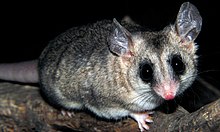
Elegant fat-tailed mouse opossum, Thylamys elegans - †Thylamys colombianus[၁၀]
- Cinderella fat-tailed mouse opossum (Thylamys cinderella)
- Thylamys citellus[၁၅]
- Elegant fat-tailed mouse opossum (Thylamys elegans)
- Thylamys fenestrae[၁၆]
- Karimi's fat-tailed mouse opossum (Thylamys karimii)
- Paraguayan fat-tailed mouse opossum (Thylamys macrurus)
- †Thylamys minutus[၁၀]
- White-bellied fat-tailed mouse opossum (Thylamys pallidior)
- Thylamys pulchellus[၁၇]
- †Thylamys pinei[၁၈]
- Common fat-tailed mouse opossum (Thylamys pusillus)
- Argentine fat-tailed mouse opossum (Thylamys sponsorius)
- Tate's fat-tailed mouse opossum (Thylamys tatei)
- Dwarf fat-tailed mouse opossum (Thylamys velutinus)
- Buff-bellied fat-tailed mouse opossum (Thylamys venustus)
- †Thylamys zettii[၁၉]
- Genus Chacodelphys
- Tribe Metachirini
ကိုးကား
[ပြင်ဆင်ရန်]- ↑ Francisco Goin (2007). "Los Metatheria sudamericanos de comienzos del Neógeno (Mioceno Temprano, Edad-mamífero Colhuehuapense). Parte I: Introducción, Didelphimorphia y Sparassodonta". Ameghiniana 44 (1): 29–71.
- ↑ မြန်မာ့စွယ်စုံကျမ်း၊ အတွဲ(၁၅)
- ↑ ၃.၀ ၃.၁ Voss, Robert S. (2009). "Phylogenetic relationships and classification of didelphid marsupials, an extant radiation of New World metatherian mammals". Bulletin of the American Museum of Natural History 322: 1–177. doi:.
- ↑ "Inferring the mammal tree: Species-level sets of phylogenies for questions in ecology, evolution and conservation" (2019). PLOS Biol 17 (12): e3000494. doi:. PMID 31800571.
- ↑ ၅.၀ ၅.၁ ၅.၂ ၅.၃ ၅.၄ ၅.၅ ၅.၆ Goin, Francisco J. (1996). "Revision de las especies del genero Hyperdidelphys Ameghino, 1904 (Mammalia, Marsupialia, Didelphidae. Su significacion filogenetica, estratigrafica y adaptativa en el Neogeno del Cono Sur sudamericano". Estudios Geologicos 52 (5–6): 327–359. doi:.
- ↑ Goin, Francisco J. (2011). "Contribution to the knowledge of living representatives of the genus Lutreolina Thomas, 1910 (Mammalia, Marsupialia, Didelphidae)". Historia Natural 1 (2): 15–25.
- ↑ "A new species of lutrine opossum, genus Lutreolina Thomas (Didelphidae), from the South American Yungas" (2014). Journal of Mammalogy 95 (2): 225. doi:.
- ↑ Cozzuol, Mario A. (2006). "The oldest species of Didelphis (Mammalia, Marsupialia, Didelphidae) from the late Miocene of Amazonia". Journal of Mammalogy 87 (4): 663–667. doi:.
- ↑ Goin, Francisco J. (2009). "A new large didelphid of the genus Thylophorops (Mammalia: Didelphimorphia: Didelphidae), from the late Tertiary of the Pampean Region (Argentina)". Zootaxa 2005: 35–46. doi:. Archived 17 December 2013 at the Wayback Machine.
- ↑ ၁၀.၀ ၁၀.၁ ၁၀.၂ Goin၊ Francisco J. (1997)။ "New clues for understanding Neogene marsupial radiations"။ Vertebrate Paleontology of the Miocene in Colombia. A History of the Neotropical Fauna။ Smithsonian Institution Scholarly Press။ pp. 185–204။ ISBN 978-1-56098-418-4။
- ↑ ၁၁.၀ ၁၁.၁ "Species diversity in the Monodelphis brevicaudata complex (Didelphimorphia: Didelphidae) inferred from molecular and morphological data, with the description of a new species" (2012). Zoological Journal of the Linnean Society 165: 190–223. doi:.
- ↑ Solari, S. (2016). Monodelphis handleyi. The IUCN Red List of Threatened Species doi:10.2305/IUCN.UK.2016-3.RLTS.T199833A22171921.en
- ↑ "A New Species of the Didelphid Marsupial Genus Monodelphis from Eastern Bolivia" (2012). American Museum Novitates 3740 (3740): 1. doi:.
- ↑ "A Nearly Complete Juvenile Skull of the Marsupial Sparassocynus derivatus from the Pliocene of Argentina, the Affinities of "Sparassocynids", and the Diversification of Opossums (Marsupialia; Didelphimorphia; Didelphidae)" (2019). Journal of Mammalian Evolution 27 (3): 385–417. doi:.
- ↑ Flores, D. & Teta, P. (2016). Thylamys citellus. The IUCN Red List of Threatened Species doi:10.2305/IUCN.UK.2016-2.RLTS.T199835A22172943.en
- ↑ Martin, G.M. & Flores, D. (2016). Thylamys fenestrae. The IUCN Red List of Threatened Species doi:10.2305/IUCN.UK.2016-2.RLTS.T199836A22172852.en
- ↑ Flores, D. & Teta, P. (2016). Thylamys pulchellus. The IUCN Red List of Threatened Species doi:10.2305/IUCN.UK.2016-2.RLTS.T199834A22172571.en
- ↑ "Los marsupiales (Mammalia) del Mioceno Superior de la Formacion Cerro Azul (Provincia de La Pampa, Argentina)" (2000). Estudios Geologicos 56 (1–2): 101–126. doi:.
- ↑ Goin, Francisco J. (1997). "Thylamys zettii, nueva especie de marmosino (Marsupialia, Didelphidae) del Cenozoico tardio de la region Pampeana". Ameghiniana 34 (4): 481–484.















